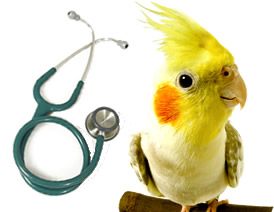
What exactly does the vet do when you visit him for the first time? I have to admit it is pretty scary to take your bird in and have absolutely no clue of what this person, whom you -in most cases- don’t know, will do to your precious baby. Of course, if you are anxious, imagine what your bird is going through! The first vet visit is very important for a number of reasons, two being overly important:
- The first visit is the one when, ideally, you decide whether or not this vet is competent to treat birds.
- It’s the perfect occasion for you to learn more about your baby.
First things first, transportation, how to make that trip the least stressful as possible? The best thing is to drive to the vet. Public transportation can be very stressful for both you and the bird. It’s often overcrowded, some people have very bad personal hygiene and some wear way too much perfume, all of which is not that good for the bird. Plus, it wouldn’t really be safe for you to be standing up on the bus and not everyone will be ready to give you his/her seat. People in the bus (or subway) push, step all over the place and do not pay attention to that carrier thingy that is in their way, so an accident could easily happen where someone kicks the cage.
There is the temperature factor to take into consideration, if it’s winter, the temperature fluctuation (home-bus-clinic-bus-home = hot-cold-hot-cold) could be harmful to the bird. If it’s raining, the bird could get wet (plus rain water= nasty water) and if it’s summer and it’s really hot… body odor comes back to mind (if it doesn’t hurt the bird, it will certainly hurt you!). The only thing that would probably not be a problem would be the danger to other issues (aside from stepping on the cage and falling all over the place) since your bird would be contained and not in a position to attack anyone.

Anyhow, if you don’t have a car or someone (family or friend) to drive you to the vet, your best bet is to take a taxi. Yes, it’s expensive, but it’s worth it considering all the bus issues mentioned above. If you take a taxi to go to the vet, there are a few things you should make sure of to ensure you get a peaceful ride. When you call for the cab, mention that you have a bird with you that will be in a pet carrier with no possibility of escape. This is important because, since you mentioned it to the operator, they will send you a driver who doesn’t mind transporting animals and who isn’t allergic to them. Call companies a few days before the appointment so you are sure that you will find one with such a driver. Also, this is very important, ask for a non-smoking driver if possible, or politely ask the driver not to smoke while you and your bird are in the car (hey, your money, your bird, your safety… tobacco is bad for everyone).
In the best-case scenario, you either have your own car or have someone who agreed to drive you to the clinic and back home. There again there should be no smoking in the car while you and the bird are in there (tobacco is bad in any car!) and the bird must be properly restrained. Make sure you know all the directions (and the address of the clinic) so you can minimize the driving time. Once you get to the clinic, have your friend drop you off in front of the clinic so you don’t have to walk much with the carrier: it will minimize the chance of accidents and temperature fluctuation.
Carriers have been mentioned several times, and here are a few suggestions as to what to use to transport your bird safely. The ideal would be to carry the bird in its regular cage, but it would have to be a pretty small cage so that’s often out of the question. A simple cardboard box with a hole pierced in it can do the job, however, it can only be used once to carry a sick bird, and birds have a tendency to chew through cardboard and should be watched carefully. Plus, most cardboard boxes are hard to close safely and the last thing you want is for your bird to get loose and escape!

3,348 total views, 1 views today
